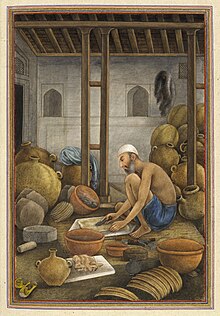| Revision as of 14:29, 1 April 2019 view sourceTimesGerman (talk | contribs)Extended confirmed users553 edits Removing unsourced content← Previous edit | Revision as of 14:30, 1 April 2019 view source TimesGerman (talk | contribs)Extended confirmed users553 edits →Notable people: Removing unsourced contentNext edit → | ||
| Line 91: | Line 91: | ||
| ==Notable people== | ==Notable people== | ||
| * ] (1934–2006), founder of Bahujan Samaj Party and mentor of Mayawati Kumari | * ] (1934–2006), founder of Bahujan Samaj Party and mentor of Mayawati Kumari | ||
| Politics | |||
| Babu Mangu Ram Muggowalia – founder of Ad-Dharam movement | |||
| Jagjivan Ram – Deputy Prime Minister of India | |||
| ==See also== | ==See also== | ||
Revision as of 14:30, 1 April 2019
This article is about the Indian caste. For the mountain in Nepal, see Chamar (mountain). Ethnic group Leather-bottle makers (Presumably members of the ‘Chamaar’ caste), Tashrih al-aqvam (1825) Leather-bottle makers (Presumably members of the ‘Chamaar’ caste), Tashrih al-aqvam (1825) | |
| Regions with significant populations | |
|---|---|
| India • Pakistan | |
| Languages | |
| Punjabi • Urdu • Hindi |
Chamar is one of the communities, who are now classified as a Scheduled Caste under modern India's system of positive discrimination. They were traditionally considered outside the Hindu ritual ranking system of castes known as varna. They are found mainly in the northern states of India and in Pakistan and Nepal.
Ramnarayan Rawat posits that the association of the Chamar community with a traditional occupation of tanning was constructed, and that the Chamars were instead historically agriculturists & Trader.
The term chamar has also been used as a pejorative word for anyone whom the describer considers to be of .
Demographics
According to the 2001 census of India, the Chamars comprise around 14 per cent of the population in the state of Uttar Pradesh and 12 percent of that in Punjab.
|
|||||||||||||||||||||||||||||||||||||||||||||||||||||||||||||||||||||||||||
The 2011 Census of India for Uttar Pradesh combined the Chamar, Dhusia, Jhusia, Jatava Scheduled Caste communities and returned a population of 22,496,047.
Occupations
Chamars who have adopted the weaving profession and abandoned tanning and leathercraft, identify themselves as Julaha Chamar; R. K. Pruthi suggests this is in the hope that they might in future be considered as Julaha by other communities in the future.. They believe that leatherwork is "degrading" when compared to weaving.
Military
The 1st Chamar Regiment was an infantry regiment formed by the British during World War II. Officially, it was created on 1 March 1943, as the 27th Battalion 2nd Punjab Regiment was converted. The Chamar Regiment was one of the army units which were awarded the Battle Honor of Kohima for their role in the Battle of Kohima. The Regiment was disbanded in 1946. Recently, several politicians have demanded that The Chamar Regiment be revived.
Notable people
- Kanshi Ram (1934–2006), founder of Bahujan Samaj Party and mentor of Mayawati Kumari
See also
References
- Yadav, Bhupendra (21 February 2012). "Aspirations of Chamars in North India". Chennai, India: The Hindu. Retrieved 14 January 2013.
{{cite news}}: Unknown parameter|deadurl=ignored (|url-status=suggested) (help) - Singh, Sanjay L. (20 August 2008). "Calling an SC 'chamar' offensive, punishable, says apex court". The Economic Times. Retrieved 12 August 2015.
- "Uttar Pradesh data highlights: the Scheduled Castes, Census of India 2001" (PDF).
- "Uttar Pradesh data highlights: the Scheduled Castes" (PDF).
- "West Bengal — DATA HIGHLIGHTS: THE SCHEDULED CASTES — Census of India 2001" (PDF). Retrieved 14 January 2013.
{{cite web}}: Unknown parameter|deadurl=ignored (|url-status=suggested) (help) - "Census table" (PDF). www.censusindia.gov.in.
- "Microsoft Word - Delhi comments.doc" (PDF). Retrieved 6 February 2017.
- "Census table" (PDF). www.censusindia.gov.in.
- "Census table" (PDF). www.censusindia.gov.in.
- ^ "State and district-wise Scheduled Castes population for each caste seperately [sic], 2011 - GUJARAT".
- Dave, Nayan (8 October 2016). "'Rohits' to replace Chamars in Gujarat". Gandhinagar: The Pioneer.
- "Census table" (PDF). www.censusindia.gov.in.
- "Census table" (PDF). www.censusindia.gov.in.
- "Census table" (PDF). www.censusindia.gov.in.
- "Census table" (PDF). www.censusindia.gov.in.
- "Census table" (PDF). www.censusindia.gov.in.
- Kapoor, Subodh (21 July 2018). "Indian Encyclopaedia". Cosmo Publications – via Google Books.
- "Census table" (PDF). www.censusindia.gov.in.
- "Census table" (PDF). www.censusindia.gov.in.
- Ram, Ronki (21 January 2017). "Internal Caste Cleavages among Dalits in Punjab". Economic & Political Weekly. 52 (3).
- "Census table" (PDF). www.censusindia.gov.in.
- Rawat, Shyam (2010). Studies in Social Protest. VEDAMS. ISBN 8131603318.
- Balai: Chamars in Bikaner region are known as Balai.
- "Census table" (PDF). www.censusindia.gov.in.
- "Census table" (PDF). www.censusindia.gov.in.
- "A-10 Individual Scheduled Caste Primary Census Abstract Data and its Appendix - Uttar Pradesh". Registrar General & Census Commissioner, India. Retrieved 4 February 2017.
- Pruthi, R. K. Indian caste system. Discovery. p. 189. Retrieved 14 April 2012.
- "Orders of Battle - 27/2 Punjab Regiment [British Commonwealth]". ordersofbattle.com. Retrieved 31 March 2011.
- "The Battle of Kohima" (PDF).
- ^ "RJD man Raghuvansh calls for reviving Chamar Regiment". indianexpress.com. Retrieved 31 March 2011.
Further reading
- Briggs, George W. (1920). The Religious Life of India — The Chamars. Calcutta: Association Press. ISBN 1-4067-5762-4.
- Rawat, Ramnarayan S. (2011). Reconsidering Untouchability: Chamars and Dalit History in North India. Indiana University Press. ISBN 9780253222626.
- Schmalz, Mathew N. (2004). "A Bibliographic Essay on Hindu and Christian Dalit Religiosity". Journal of Hindu-Christian Studies. 17: 55–65.
Categories: